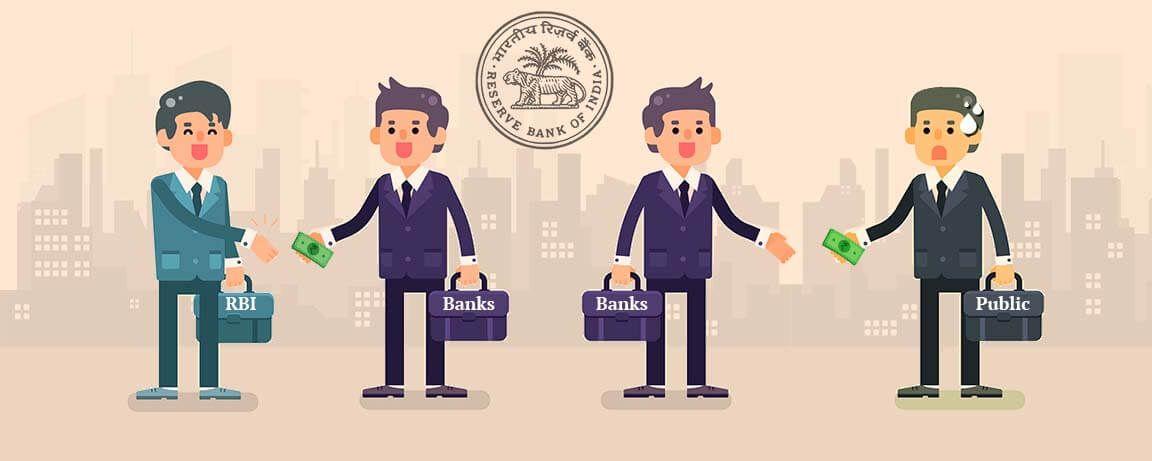Bringing on enough liquidity relief for commercial banks, NBFCs, and HFCs, the RBI Governor ShaktiKanta Das on Friday has announced a package worth Rs 1 Lakh crore.
To ease out financial stress and to maintain better credit flow, the RBI announced a consecutive drop in reserve repo ratio by 25 bps to 3.75 percent. The repo rate remained unchanged; however, it was cut by 75 basis points to 4.40 percent from 5.15 percent previously on March 27, 2020.
Besides, RBI also released Rs 50,000 crore Targeted Long-Term Repo Operation (LTRO 2.0) for meeting the liquidity mismatch of small banks and microfinance institutions. Another Rs 50000 refinance relief was announced for AIFIs like NABARD, SIDBI, and NHB for sectoral credit requirements.
In lines of easing the financial stress of small banks, the RBI further relaxed the Liquidity Coverage Ratio to 80 % from the current LCR of 100 %. The lenders can restore the same in phases by April 2021. Banks are also directed not to make any dividend payments.
All these announcements were aimed at ensuring adequate liquidity within the banking sector and enabling the normal functioning of markets.
The reduction in repo rate is an MPC’s tool to make deposits at the central bank less attractive for commercial banks. As banks will be able to lend more, it will directly pump up liquidity in the system. In the wake of COVID19 related economic disruption, the improved liquidity will enhance investor confidence. The banks could lend at ease to borrowers.
Earlier on March 27, RBI had slashed the reverse repo rate by 90 basis points to 4 percent from 4.90. The message has been clear: Do not passively park money but lend, lend & lend more for powering the economy.
FAQs
✅ What is Reverse Repo Rate?
The reserve repo rate is a rate of interest banks earn from lending money to RBI. It is essentially a monetary policy instrument used by RBI to control money movement in the economy.
In times of cash crunch, the reverse repo rate is increased and banks are incentivised by parking money with RBI. The higher reserve repo rate make it attractive for banks to place their money with RBI.
✅ How does Reverse Repo Rate impact the customers?
The Reverse Repo Rate a Monetary Policy tool used often by the central bank to control or release liquidity in the economy. It directly also affects the inflation of the country.
✅ How repo rate and reverse repo rate are different?
Repo Rate is a rate at which the banks borrow money from the RBI. As the name suggest, reverse repo rate is opposite of repo rate-the rate at which RBI borrows from banks.
✅ How does change in reverse repo rate affect system?
If Reverse Repo Rate is increased, banks are basically incentivised on a short-term basis to park their surplus funds with RBI. This will cause loss of money from the system thus thereby creating liquidity crunch in the market. Generally RBI absorbs surplus money against government securities on overnight basis under the Liquidity Adjustment Facility (LAF). This time however, the RBI has reduced repo rate and thus made available additional funds to banks for lending.
✅ Why Repo Rate is always higher than Reverse Repo Rate?
The difference between repo rate and reverse repo rate is RBI’s income. RBI needs to earn for lending to banks and thus its borrowing rate or reverse repo rate is always lower.
Also, by keeping Reverse Repo Rate low, the central bank wants to discourage banks from parking surplus funds with RBI.
✅ How is Reverse Repo Rate calculated?
The Reverse Repo Rate in India is determined by Monetary Policy Committee (MPC). The RBI Governor heads the panel and the meeting is held bi-monthly to announce the economic outlook and benchmark lending rate.
✅ How will cut in Reverse Repo rate affect Personal Loan & Home Loan interest rates?
By reducing repo rate consecutively, the reserve bank of India has been regularly discouraging commercial banks from parking money with RBI. This leaves more funds in the hands of bank to lend to individuals and businesses. Thus, today’s reserve repo rate cut will further make it possible for banks to lend at lower rate to individuals and businesses.
✅ How Reverse Repo Rate change is related to inflation?
As RBI reduces the reverse repo rate it will boost money supply in the economy thus inducing demand and supply movement & charging up inflationary factors.
✅ Will Reverse Repo Rate also impact Indian Rupee?
Today’s rate cut will increase the money supply and thus slightly weaken the strength of the rupee.
